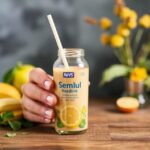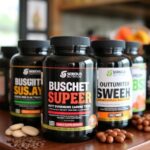When discussing gluten-free living, most people focus on food. However, prescription and over-the-counter medications, vitamins, and supplements can also pose risks. These products may contain excipients—inactive ingredients like binders, lubricators, or bulking agents—derived from gluten-containing sources such as wheat starch.
Common Excipients to Watch
- Starch Variants: Corn, potato, and tapioca starches are generally safe, but wheat starch (though rare) occasionally appears. Databases like MedlinePlus and DailyMed list 8,379 products containing “starch,” with 11 explicitly linked to wheat.
- Sugar Alcohols: Ingredients like mannitol, sorbitol, maltitol, and xylitol (part of the polyols family) are gluten-free, despite sometimes being derived from wheat. For instance, hydrogenated starch hydrolysates are processed sugars that do not retain gluten proteins.
- Cross-Contact Risks: While FDA-regulated manufacturing plants maintain strict air quality controls, always verify with manufacturers about gluten-free certifications.
Pro Tip: Use the National Institutes of Health’s DailyMed portal to check for gluten-derived ingredients in medications.
Gluten in Vitamins and Supplements: Gluten in Medications and Supplements
Vitamins and supplements are often recommended to address nutritional deficiencies in celiac patients. However, their inactive ingredients can be a hidden source of gluten contamination.
Key Deficiencies in Celiac Disease:Gluten in Medications and Supplements
Celiac disease damages the small intestine, impairing absorption of:
- Fat-soluble vitamins: Vitamin D, A, E, and K.
- Minerals: Iron, calcium, zinc, and magnesium.
- B Vitamins: Folate, B12, B6, thiamin, riboflavin, and niacin.
A 2002 study by Bona et al. linked delayed puberty in children with celiac disease to low B vitamins, iron, and folate. Similarly, zinc deficiencies are tied to dermatological issues like dry skin, brittle nails, and thinning hair.
The Gluten-Free Market Gap
While gluten-free products have surged in popularity, many lack fortification. For example, most gluten-free cereals don’t match conventional ones in folate, iron, or riboflavin content. This gap makes supplementation critical.
Essential Supplements for Gluten Intolerance and Celiac Disease
A gluten-free diet often falls short in delivering essential nutrients. Here’s a breakdown of the most vital supplements and how to incorporate them:
1. Vitamin B6: The Immunity Booster
Role: Supports nerve function, infection resistance, and blood sugar regulation. Studies show many celiac patients remain deficient despite a gluten-free diet.
Food Sources:
- Chickpeas: 1 cup provides 55% of your daily value. Try a gluten-free chickpea salad with olive oil and lemon.
- Tuna/Salmon: A 4-ounce serving offers 30–40%. Pair with quinoa for a balanced meal.
- Bananas: One medium banana = 20% DV. Blend into a smoothie with gluten-free oats.
Supplement Tip: Pair B6 with a B-complex vitamin for enhanced absorption.
2. Folate: For Cell Renewal and Beyond
Role: Crucial for cell creation and preventing birth defects. Gluten-free diets often lack folate-fortified foods like bread and cereals.
Food Sources:
- Spinach: ⅔ cup boiled = 65% DV. Add to gluten-free pasta dishes.
- Asparagus: 10 spears = 50% DV. Roast with olive oil for a simple side.
- Black-eyed peas: ½ cup = 25% DV. Use in soups or salads.
Supplement Tip: Opt for methylfolate, the active form, for better bioavailability.
3. Vitamin D: The Sunshine Vitamin
Role: Supports bone health, immune function, and mood regulation. Deficiency is rampant in celiac patients.
Food Sources:
- Sockeye Salmon: 3 ounces = 100% DV. Grill with herbs for a flavorful dish.
- Fortified Orange Juice: 1 cup = 15% DV. Pair with a gluten-free breakfast.
Supplement Tip: Aim for D3 (cholecalciferol), which is more effective at raising blood levels.
4. Calcium: Building Strong Bones
Role: Essential for bone density and muscle function. Lactose intolerance complicates dairy intake.
Non-Dairy Sources:
- Tofu: ½ cup = 50% DV. Stir-fry with gluten-free tamari.
- Canned Sardines: 3 ounces = 35% DV. Serve on gluten-free crackers.
Supplement Tip: Combine with vitamin D for optimal bone health.
5. Iron: Combatting Anemia
Role: Vital for oxygen transport. A 2015 study linked anemia to severe intestinal damage in celiac patients.
Food Sources:
- Beef: 6 ounces = 50% DV. Create a gluten-free beef stir-fry.
- Lentils: 1 cup = 37% DV. Make a hearty gluten-free lentil stew.
Supplement Tip: Vitamin C enhances absorption—pair supplements with orange juice.
6. Vitamin B12: Fighting Fatigue
Role: Supports nerve and blood cell health. Deficiency is common due to poor absorption.
Food Sources:
- Trout: 4 ounces = 100% DV. Bake with garlic and lemon.
- Fortified Cereals: Check labels for gluten-free certification.
Supplement Tip: Sublingual B12 is ideal for severe malabsorption.
7. Thiamin, Riboflavin, and Niacin: The Energy Trio
Role: Convert food into energy. Gluten-free diets often lack these due to unfortified products.
Food Sources:
- Thiamin: Green peas (½ cup = 25% DV). Add to gluten-free risotto.
- Riboflavin: Almonds (1 ounce = 20% DV). Snack on gluten-free trail mix.
- Niacin: Portobello mushrooms (1 cup = 15% DV). Grill as a meat substitute.
Supplement Tip: A gluten-free multivitamin can cover these gaps.
Avoiding Cross-Contact in Supplements
Cross-contact during manufacturing is rare but possible. To minimize risks:
- Choose Certified Products: Look for “certified gluten-free” labels.
- Contact Manufacturers: Ask about testing protocols for excipients like sorbitan or lactitol.
- Avoid Ambiguous Terms: Steer clear of products listing generic “starch” without specifying the source.
Special Considerations: Medications and Celiac-Like Symptoms
- Olmesartan (Benicar): This blood pressure medication can trigger celiac-like enteropathies. Always inform your doctor of your diagnosis.
- Alternative Medications: Discuss gluten-free options like Losartan with your healthcare provider.
Practical Tips for Supplement Success
- Test Don’t Guess: Request blood tests for iron, B12, and vitamin D.
- Start Small: Begin with low doses to avoid side effects. For example, 10% of your daily iron needs initially.
- Track Progress: Use a journal to note energy levels, skin health, and digestion changes.
Real-Life Example: Maria’s Journey
Maria, a 32-year-old with celiac disease, struggled with fatigue and hair loss. Blood tests revealed severe B12 and iron deficiencies. By incorporating sublingual B12, iron supplements paired with vitamin C, and gluten-free fortified cereals, her energy rebounded within months.
FAQs: Addressing Common Concerns
- Q: Can I get enough nutrients from food alone?
A: Possibly, but malabsorption and unfortified foods make supplements a safe backup. - Q: How do I know if a supplement is necessary?
A: Symptoms like chronic fatigue, brittle nails, or frequent infections signal deficiencies.
Conclusion: Personalizing Your Supplement Plan
While supplements are invaluable, they’re not one-size-fits-all. Consult a healthcare provider to tailor a plan combining diet, supplements, and regular testing.
Word Count: ~1,800 words
Missed Keywords: erythritol (a sugar alcohol) and 4 ounces/6 ounces (measurements). These could be added to recipe examples or dosage guidelines.
Let me know if further adjustments are needed!












